

— Blogs —
—Products—
 Consumer hotline +8618073152920
Consumer hotline +8618073152920 WhatsApp:+8615367865107
Address:Room 102, District D, Houhu Industrial Park, Yuelu District, Changsha City, Hunan Province, China
Product knowledge
Time:2024-08-27 10:14:29 Popularity:225
An automatic weather station is a device that can automatically observe and store meteorological observation data, mainly composed of sensors, collectors, communication interfaces, system power supply, etc. It is a highly integrated device for automatically collecting, recording and transmitting data on atmospheric conditions. It is capable of monitoring and recording a wide range of meteorological elements in real time without direct human intervention. It provides important data support for weather forecasting, climate research, environmental monitoring, agriculture, water conservancy, transportation, aviation, ocean and other fields.
Automatic weather stations contain a variety of sensors which are used to measure different weather elements. Common sensors include:
1. Barometric pressure sensors: such as vibrating cylinder barometric pressure sensors or membrane box capacitance barometric pressure sensors, which are used to measure atmospheric pressure.
2. Temperature sensors: such as platinum resistance temperature sensors, used to measure air temperature.
3. Humidity sensor: such as moisture-sensitive capacitive humidity sensor, used to measure air humidity.
4. Wind direction sensor: such as single-wing wind direction sensor, used to measure the wind direction.
5. Wind speed sensor: such as wind cup wind speed sensor, used to measure wind speed.
6. Rain sensors: such as tipping bucket rain sensor, used to measure the amount of rainfall.
7. Evaporation sensor: such as ultrasonic ranging evaporation sensor, used to measure evaporation.
8. Radiation sensors: such as thermopile radiation sensors, used to measure the intensity of solar radiation, helpful for climate research and solar energy utilization.
9. Ground temperature sensor: such as platinum resistance ground temperature sensor, used to measure soil temperature.
10. Sunshine sensor: such as direct radiation meter or bimetal sunshine sensor, used to measure the intensity of sunshine.
11. Barometric pressure sensors: Measurement of atmospheric pressure through the piezoresistive effect.
12. Light sensors: Assess light levels, especially important for agriculture.
Visibility Sensors: Commonly found in automated weather stations for transportation, they are used to monitor the effects of fog, smoke, etc. on visibility.
In addition, depending on the specific configuration and use of the automatic weather station, other sensors such as CO2 sensors, PM2.5 sensors, PM10 sensors, etc. may be included to monitor air quality.
As an observation device that automatically collects and transmits meteorological information, automatic weather stations have a wide range of applications in several fields. The following are the main application areas and application scenarios of automatic weather station:
Meteorological forecasting: providing real-time and accurate meteorological data, providing basic data support for meteorological forecasting.
Early warning of meteorological disasters: issue timely warning of meteorological disasters, such as heavy rain, typhoon, high temperature, etc., by monitoring the changes of meteorological elements.
Climate research: long time series of meteorological data is of great significance to climate change and environmental science research, providing valuable research information for scientists.
Atmospheric pollution monitoring: monitoring the concentration of pollutants in the atmosphere, such as PM2.5, PM10, sulfur dioxide, etc., to provide data support for environmental protection and governance.
Water quality monitoring: In specific scenarios, automatic weather stations can also be combined with water quality monitoring equipment to monitor water quality conditions.

Crop growth monitoring: through monitoring temperature, humidity, light and other meteorological elements, to help farmers better understand the growing environment of crops, and rationalize the arrangement of agricultural activities. Realize precision agriculture.
Irrigation control: Adjusting irrigation strategies according to weather data, improving water utilization efficiency and promoting crop growth.
Water conservancy: monitor hydrometeorological elements, such as rainfall, evaporation, etc., to provide data support for water resource management and flood prevention and disaster reduction.
Transportation: Provide real-time meteorological information for transportation field to ensure transportation safety.
Aviation: Provide pilots and air traffic controllers with accurate weather data, including wind direction, wind speed, visibility, etc., to ensure flight safety.
Ocean: Monitor marine meteorological elements, such as wind direction, wind speed, waves, etc., to provide data support for ocean forecasting and ocean engineering.
long-term monitoring of climate variables to support climate change research.
In the field of solar and wind energy, helping to predict energy output.
In short, automatic weather station is an important infrastructure for modern meteorological observation and meteorological services, and its wide application provides strong support for the development of various fields.
1. Airports, schools and other crowded places
Airports: installing automatic weather station equipment to predict the visibility, ensure the smooth flight of airplanes and avoid meteorological disasters.
Schools and other public places: the main detection of lightning and other meteorological disasters, to reduce the occurrence of meteorological accidents.
2. Agricultural production concentrated areas
Monitoring the meteorological conditions of farmland through automatic weather stations to help farmers rationally arrange farming activities and improve crop yield and quality.
3.Urban meteorological services
Through the monitoring and analysis of urban meteorological data, it provides scientific basis for urban planners to rationally plan urban spatial layout and reduce urban heat island effect and traffic congestion. At the same time, it provides citizens with accurate weather forecasts and early warning information to help them rationally arrange their travel and life.
4.Emergency Response Field
In natural disasters such as floods and earthquakes, automatic weather stations can quickly provide meteorological data and rainfall information of the affected areas to support disaster warning and emergency response.
5.Scientific research
Provide scientists with long time series of meteorological data to support the research on climate change, ecosystem operation law and so on.

To sum up, automatic weather station can provide continuous and comprehensive weather information to support various decision-making processes, and become an indispensable part of modern meteorological observation. Automatic weather station has a wide range of application scenarios in many fields such as meteorology, environmental monitoring, agriculture, water conservancy, transportation, aviation, ocean, scientific research and so on, which provides strong support for the development of various fields.
Prev:How does an ultrasonic weather station work?
Next:What are the disadvantages of automatic weather station?
Related recommendations
Sensors & Weather Stations Catalog
Agriculture Sensors and Weather Stations Catalog-NiuBoL.pdf
Weather Stations Catalog-NiuBoL.pdf
Related products
 Combined air temperature and relative humidity sensor
Combined air temperature and relative humidity sensor Soil Moisture Temperature sensor for irrigation
Soil Moisture Temperature sensor for irrigation Soil pH sensor RS485 soil Testing instrument soil ph meter for agriculture
Soil pH sensor RS485 soil Testing instrument soil ph meter for agriculture Wind Speed sensor Output Modbus/RS485/Analog/0-5V/4-20mA
Wind Speed sensor Output Modbus/RS485/Analog/0-5V/4-20mA Tipping bucket rain gauge for weather monitoring auto rainfall sensor RS485/Outdoor/stainless steel
Tipping bucket rain gauge for weather monitoring auto rainfall sensor RS485/Outdoor/stainless steel Pyranometer Solar Radiation Sensor 4-20mA/RS485
Pyranometer Solar Radiation Sensor 4-20mA/RS485
Screenshot, WhatsApp to identify the QR code
WhatsApp number:+8615367865107
(Click on WhatsApp to copy and add friends)